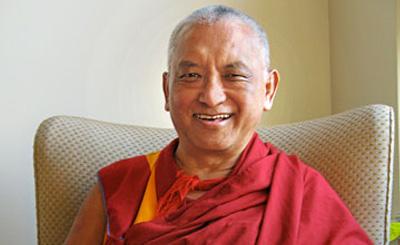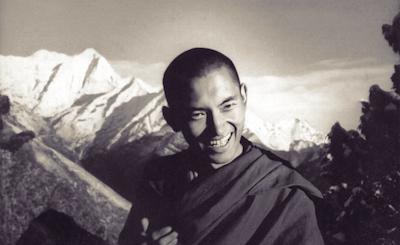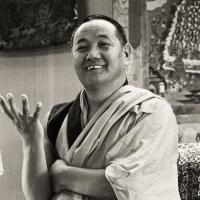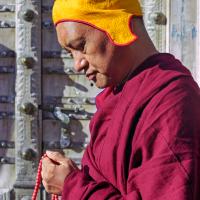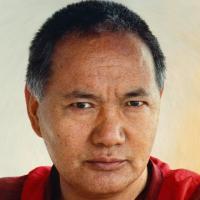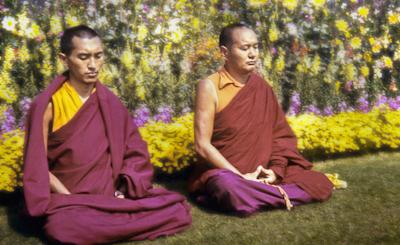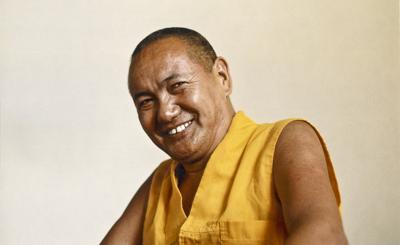The main body of the yoga meditation begins with the shunyata mantra, OM SVABHAVA SHUDDHO SARVA DHARMA SVABHAVA SHUDDHO HAM.
First, it’s significant that the words of this mantra are the original Sanskrit—just hearing or reciting them imparts great blessings.
Also, this mantra contains a profound explanation of the pure, fundamental nature of both human beings and all other existent phenomena. It means that everything is spontaneously pure—not relatively, of course, but in the absolute sense. From the absolute point of view, the fundamental quality of human beings and the nature of all things is purity.
We need to understand what the mantra means by “nature,” or “natural.” Much of the time we are unnatural; we go against our nature. Our ego tries to be clever and intelligent; it’s always dreaming up ways to generate hatred, anger and desire, but that’s bad, negative intelligence. It creates an artificial self and then believes that this artificial self is the real me: “This is me; look how beautiful I am.” We present an artificial emanation to ourselves, believe that this false image is real, and then present ourselves to others in that way.
As long as we’re on this kind of psychological ego trip we can never be natural. In order to touch our fundamental nature we have to go beyond our false self. When we do, we touch purity.
Thus the shunyata mantra also shows that the self-pity wrong conception that constantly repeats in our mind—“I’m hopeless, I’m impure, I’m a bad person, I’m evil, I can’t do anything, I can’t help myself, I can’t help others”—is completely deluded and an unnatural way to think. In other words, Lord Buddha’s philosophy and psychology teach us that we should not believe that we are totally negative or sinful by nature. That’s absolutely incorrect. Our fundamental nature is pure. The artificial cloud projected by our ego is not our nature; it’s just something fabricated by our intellectual ego. Therefore, we should disregard this wrong view and just be natural, as we are.
Let me give you an example of how we’re not natural. Look at how people have changed through the history of human evolution. Women have changed their image; men have changed the way they work. Have you noticed? I have. I don’t look at the world from only the religious point of view; I observe human history, too. This kind of change explains the generation gap: old people don’t understand the way young people act. They look at them and think, “What on earth is that?” Young people look at the elderly and think they’re out of touch. They see their peers acting and dressing in a certain way, believe that that’s the best way to be, and adopt a new kind of emanation. But it’s completely artificial, not at all natural. Therefore, through understanding the fundamental nature of the human being, we should try to be natural.
The shunyata mantra shows the positive reality of what a human is. Why should we have only a negative self-image? That’s just ego. And that’s why Buddhism never has anything good to say about the ego. From our point of view, the ego is always bad because all it brings is suffering. And that’s why we practice meditation—it’s the way we transcend artificial thought, gain peaceful tranquility and touch our fundamental reality.
Reciting the shunyata mantra helps us cut the conceptions that lead us to misery, such as ideas of permanence and the inherent existence of the self. Such conceptions should be cut. If they are not completely eradicated they just build up; they diminish today and tomorrow recur. We have no control. We suppress something here, it comes out there; we suppress something there, it comes out here. Sublimating problems is no solution.
Anyway, whether or not you recite the shunyata mantra, the important thing to understand is that the self-pity image of yourself to which you cling does not exist. I could easily explain this in a detailed, philosophical way but the simple approach is to look at how you hold yourself today—“I am that-this”—and compare that with how you held yourself last year. Do you hold yourself the same way or has your self-conception changed? It’s actually very difficult for that to change—we always feel that the “me” of today is exactly the same as the “me” of last year. But of course, that’s wrong, both relatively and absolutely.
First of all, things are constantly changing in the shortest fraction of a second. There’s no way that the Mr. Jones of today can be exactly the same as the Mr. Jones of yesterday. It’s just not possible. And when you clearly see the way in which you hold a permanent self-image, all you can do is laugh at yourself. It’s just so nonsensical. You believe that you’re the same person you were ten years ago. That’s what Lord Buddha meant when he said that we’re deluded, deluded, deluded!
Deluded means holding and hanging on to nonsensical conceptions and hallucinated projections of ourselves and as long as we don’t eradicate this cause of all problems, we’re not doing a good job. We can meditate for twenty or thirty years but if we don’t touch the root of problems, if we don’t shake our ego, if all we do is make it more beautiful and solid, we’re not doing a good job at all.
What we need to do is to shake our samsara, the root of ego, the way our ego conception holds things. When we shake the Mt. Meru of our ego, our entire samsaric mandala collapses. That’s a real earthquake.
Lord Buddha’s teaching on universal reality is so profound. It shows us the best way to be healthy by shattering all our concepts and illusions. He said, “Even if you hold concepts of me, the Buddha, you’re still trapped in samsara.”
The so-called religious practitioners of today are going to run to their guru saying, “You’re a fantastic guru, I love you; please love me.” They’re going to want their self-existent guru to love their self-existent selves. That’s their ego at work. If people had run up to the Buddha like that he’d have told them to get lost. That’s beautiful. Lord Buddha didn’t want people to be hung up grasping at anything, much less him and his doctrine. He said that such people were foolish; that that was no way to be healthy. He said even if we’re attached to the bodhisattva path, the six perfections, the tantric path—any Buddhist philosophy—we’re trapped.
It’s very simple. Lord Buddha made no exceptions. He said that we should grasp at neither samsaric nor religious phenomena, not even Buddhist philosophy. His aim was universal health.
We also find that many gurus are attached to their disciples and want their disciples to be attached to them. That’s totally wrong, too. Gurus should not be attached to their disciples; disciples should not be attached to their guru. True spiritual practitioners should not be attached to any person, doctrine or philosophy. It’s unhealthy. The Buddha taught so that we might also become buddha: healthy, eternally happy and free of all concepts, misery, doctrine and bondage. That’s all he wanted.
Therefore we have to recognize the falsity of the conception of the permanent, concrete self of last year that we’re clinging to right now and break it down; we have to see how our ego-grasping creates an atmosphere of ignorance within which we then grasp at sense pleasures, which tantalize and trick us by their dancing in the dark.
This shunyata mantra is most profound: “All existent phenomena in the universe and I are of one reality.” At the moment, our ego divides us from other phenomena. It says, “You are this, this, this; I am that, that, that.” It keeps us from getting close to even our loved ones. We spend our whole life with another person but never get really close because of the games our ego plays. Our ego prevents us from understanding one another.
The mantra finishes with, “That is me,” HAM. “All existent phenomena in the universe and I are of one reality and that is me; I am that.” This signifies divine pride. Through experiencing shunyata we experience a kind of unity of self and other, like pouring milk into milk. When you mix two lots of milk they become indistinguishable from one another. That is the beauty of the nature of shunyata—understanding, experiencing or realizing it makes our dualistic mind vanish. Dual means two; relatively speaking, you and I are dual. But from the ultimate point of view, when I realize my universal nature and yours, we become indistinguishable.
People talk about racism: it’s a bad thing, we should do away with it; many people have been killed as a result of racism. From the Buddhist point of view, without destroying the dualistic ego there’s no way to eliminate racism; it’s too deeply rooted within. So until we discover the reality of universal unity, any talk of racism disappearing is a joke. It’s just not possible.
However, Lord Buddha gave precise, practical teachings on overcoming duality that we can implement in our everyday life. That’s the beauty of being human; that’s why from the Buddhist point of view, humans are beautiful. In the relative world we can practice charity and so forth but we can also transcend the relative world; we’re capable of both functioning in the relative world and going beyond it into the absolute.
Experiencing emptiness
From the practical point of view, tantric techniques help us gain direct experience of shunyata. The usual way to do this is to first visualize the deity that you are practicing—Maitreya, for example—in space in front of you, seeing this deity as your guru, a buddha or a bodhisattva, depending upon your level of understanding. A laser-like beam of radiant white light emanates from Maitreya’s heart and shoots into your heart, transforming all the energy of the self-pity image you have of yourself into radiant white light. This white light image of yourself then gradually dissolves, becoming smaller and smaller until it completely disappears into the space of non-duality. Then, with complete awareness, you concentrate single-pointedly on that.
This technique for experiencing emptiness epitomizes the tantric approach. Lord Buddha taught tantra so that we could not only understand emptiness intellectually but also to experience it directly.
If you want to practice this technique right now, do it as follows. First, close your eyes. We meditate with our eyes closed because, from the Buddhist point of view, sense perception is no good—the moment we open our eyes we’re assailed by dualistic impressions. So close your eyes and visualize Maitreya in the space in front of you. As if magnetically attracted, a laser beam of radiant white light shoots out of his heart into yours, instantly burning up your entire concrete self-image. This nuclear energy transforms your body into radiant white light. It gets smaller and smaller, dissolves into atoms, neutrons…and completely disappears into selflessness. Remain in this state, fully aware, and just experience it without any intellectualization; just let go.
[Meditation]
Your normal, ego-conceived self-image disappears. Think strongly that it has completely gone. Let go.
[Meditation]
Think, “My self-pity image of myself is universal reality.” Feel this, fully aware; let go without intellectualization.
[Meditation]
Think, “In the great universal reality of emptiness there’s no form, no color, no substantial physical energy.”
[Meditation]
“The view and experience of non-duality is great peace. This is the experience of enlightenment.”
[Meditation]







